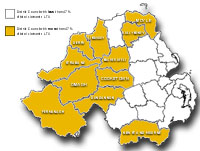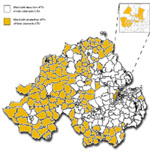Annex 2: Department of Economic Development Draft New TSN Action Plan
1
1.1Departmental Aims and Objectives
The Department of Economic Developments (DED) vision is to achieve a Northern Ireland economy which provides worthwhile opportunities for everyone. The aim is for an economy characterised by:
- high
levels of sustainable economic activity and employment
- income
per head at least equal to the EU average
- low unemployment, with a significantly reduced proportion of long-term unemployment.
In pursuit of this aim two key Departmental objectives have been identified:
- to
promote employment and investment for sustainable economic growth and
the improvement of competitiveness in business and industry
- to enhance opportunity and fairness.
With regard to the second Departmental objective the following results are sought:
- effective
reconnection of the long-term unemployed to the labour market
- a more equal distribution of the benefits of economic growth, through targeting in particular those individuals and areas in greatest need.
2
2.1
Targeting Social Need Action Plans 1995-1998
Over the years DED has developed a range of complementary approaches aimed at tackling need. The 1995 Strategy Document Growing Competitively sharpened the focus by making Targeting Social Need a more integral part of the overall strategy and 3 year Targeting Social Need Action Plans (1995-1998) were set in place by DEDs five economic development agencies: Industrial Development Board (IDB), Training and Employment Agency (T&EA), Local Enterprise Development Unit (LEDU), Industrial Research and Technology Unit (IRTU) and Northern Ireland Tourist Board (NITB). In its 1997 Report on employment equality "Building for the Future", SACHR welcomed DEDs Action Plans as a model for other Departments.
3
3.1
DED Commitment to New TSN
DED has revised its earlier commitment to Targeting Social Need within Growing Competitively as follows:
"In consultation with the private sector and social partners, DED and its agencies will pursue policies which effectively target individuals in greatest need, particularly the long-term unemployed, and also areas in greatest need, with the effect of reducing community differentials."4
4.1
Unemployment Levels
Unemployment levels in Northern Ireland have largely been on a downward trend for the past 5 years. The seasonally adjusted level of unemployment (using the claimant measure) at September 1999 was 46,900 or 6.1% of the workforce. However the level of long term unemployment (over twelve months and based on the computerised claimant count) has remained consistently and unacceptably high, with some 37.3% (18,576) of claimant unemployed in Northern Ireland being unemployed for over 1 year compared with 25% in the UK as a whole. The focus of activities must therefore be on developing the environment which will offer greater opportunities for the unemployed, in particular the long-term unemployed, to return to the labour market.
5
5.1
Enhanced Monitoring
While there is already significant monitoring within DED, a further enhancement of monitoring systems is planned to capture additional information on the individuals gaining employment from DED and DED-managed EU programmes. A co-ordinated monitoring system, involving the five economic development agencies and appropriate parts of DED Headquarters is being developed to capture the following data on those gaining employment from new or expansion projects: location of individual (postcode); gender; disability; previous economic activity status (ie employee, self-employed, unemployed, education or economically inactive) and community background.
6
6.1
Targeting
In considering how best to target both efforts and resources, DED has considered carefully its use in its earlier Targeting Social Need Action Plans of the Robson Indicators of multiple deprivation, which were based on the 1991 Census data. While there was a correlation between the Robson index and unemployment levels at that time, there has been a considerable change in the levels and composition of unemployment throughout Northern Ireland since 1991. For example, since 1991 claimant count unemployment has fallen by 43,200 (43%) and long-term unemployment by some 24,000 (almost 50%). The age distribution of claimants has also changed with proportionately fewer younger claimants and more claimants in the 40-55 age bands in 1998 than in 1991.
The maps have been derived to coincide with areas (at both ward and District Council level) which exhibit the highest proportions of long-term unemployment. Using the average levels of unemployment during 1998 to smooth out both the seasonal fluctuations in the profile of unemployment and the impact of any labour market "shocks" such as redundancies, long-term unemployed was taken as a proportion of the total claimant count. Ranking the District Councils (from highest to lowest in terms of these proportions) highlighted a "natural break" in the distribution. This cut off point, at over 47% of claimant unemployed in the long-term category, results in 11 District Councils and 195 wards being designated as areas of greatest disadvantage or "New TSN areas". The main focus of DED's geographical targeting activity will be at Council level with the ward maps providing greater detail for monitoring purposes. The proposed Council and ward maps are shown overleaf.
|
|
|
Wards in Northern Ireland with 47% or more of claimants long term unemployed (ie unemployed for one year or more)
| District Council Area | Ward |
|
ANTRIM |
Cranfield |
|
ARDS |
Ballywalter |
|
ARMAGH |
Callan Bridge |
|
BALLYMENA |
Craigywarren |
|
BALLYMONEY |
Ballyhoe &
Corkey |
|
BELFAST |
Andersonstown |
|
CARRICKFERGUS |
Sunnylands |
|
CASTLEREAGH |
Enler |
|
COLERAINE |
Agivey |
|
COOKSTOWN |
Ardboe |
|
CRAIGAVON |
Ballyoran |
|
DERRY |
Banagher |
|
DOWN |
Dundrum |
|
DUNGANNON |
Altmore |
|
FERMANAGH |
Belcoo &
Garrison |
|
LIMAVADY |
Binevenagh |
|
LISBURN |
Collin Glen |
|
MAGHERAFELT |
Ballymaguigan |
|
MOYLE |
Armoy |
|
NEWRY& MOURNE |
Annalong |
|
NEWRY & MOURNE |
Silver Bridge |
|
NEWTOWNABBEY |
Ballyclare North |
|
NORTH DOWN |
Whitehill |
|
OMAGH |
Beragh |
|
STRABANE |
Artigarvan |
IDB will continue with its policy of offering enhanced levels of assistance to companies locating in these designated Council areas. In addition, there is a high concentration of New TSN wards within the Armagh City and District Council and Belfast City Council areas which account for more than 50% of the long-term unemployed for the Council area. IDB will have the flexibility to treat these areas as exceptional cases for enhanced levels of assistance. For Belfast City Council area alone, projects locating immediately adjacent to wards designated for New TSN purposes (including the IDB site at Springbank, which is located in the Poleglass area but situated within the Lisburn Borough Council Area) will be eligible for enhanced rates of support. One of the key criteria for enhanced assistance to all areas designated for New TSN purposes will be a commitment by companies to work with IDB and T&EA to maximise the employment opportunities for the long-term unemployed. As part of its enhanced monitoring, IDB will, as noted above, track the location of people employed by such projects.

